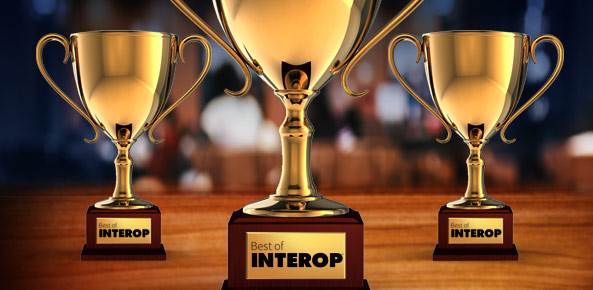When the Best of Interop winners were announced May 4 in Las Vegas, newcomer AppFormix was one of the big winners, taking home three prizes for its role in advancing enterprise cloud operations. AppFormix received the award for Best Cloud/Virtualization Product and Best Startup, in addition to being named the Grand Award winner.
Long-time industry leader Cisco was the other big winner, racking up trophies in four categories: Networking, Data Center, Mobility, and Security.
Here’s a quick look at the Best of Interop winners and finalists in each category.
Best Cloud/Virtualization
It’s impressive for AppFormix to have won for Best Cloud/Virtualization category, given that the company just emerged from stealth mode less than a year ago, in June 2015. AppFormix won for its real-time management technology designed for hybrid cloud infrastructures. The AppFormix optimization platform uses advanced analytics and orchestration to boost performance of apps running in hybrid cloud- as well as private-cloud environments.
The other two finalists in the Cloud/Virtualization category were Veeam for its Cloud Connect Replication for Service Providers (a data-center service that helps enterprises improve recovery time and point objectives), and Cloud On-Ramp as a Service with VeloCloud Gateways (a service that simplifies branch WAN networking by automating deployment and improving performance over private, broadband Internet and LTE links).
Best Performance/Management/Monitoring
Another startup — Pluribus Networks — received recognition, winning this category with its network performance management solution, called VCF Insight Analytics.
Pluribus VCF-IA is a low-cost network monitoring solution for branch offices and campus networks that works with Pluribus or non-Pluribus software-defined networks. The judges noted the importance of a performance monitoring solution that can fully support software defined networking (SDN) in data center environments, and agreed that VCF Insight Analytics helps fill that critical need.
Other finalists in the category were ExtraHop Explore (a data analytics appliance for managing transaction and flow records) and the Uila for its Virtual Infrastructure Performance Management solution.
Best Networking Product
No beginner’s luck here. Old-timer Cisco won the Best Networking prize with its Cisco Enterprise Network Function Virtualization (NFV) solution that creates a framework for deploying and managing virtual network devices.
Enterprise NFV works with iWAN and the ASA firewall on generic x86 platforms, and also supports third-party network functions. It is optimized for data centers as well as remote office/branch office environments, and licenses are portable from physical to virtual appliances for maximum flexibility.
Cisco was up against two other finalists: VeloCloud for its Cloud-Delivered SD-WAN (a branch WAN networking service that automates deployment and optimizes performance), and ExtraHop for its Discover 1100 Appliance (a data analytics tool for managing network traffic).
Best Data Center Product
Cisco also won the Data Center category, this time with its Cisco Nexus Fabric Manager (CNFM) appliance that simplifies deployment and configuration for Cisco Nexus 9000 switches running in NX-OS mode.
Once again, the story was about simplifying network management to save time and resources. The judges pointed out that the Cisco Nexus Fabric Manager excels by providing a unified tool for monitoring and managing even complex networks as a single dynamic entity.
The two other finalists here were CrossCage Plus (a colocation data center cross-connect request service provider), and Puppet Enterprise 2015.3 (an automation platform for delivery and operation of enterprise software).
Best Security Solution
The Security prize went to Cisco FirePower, described as an advanced, next-generation firewall that is unique for its ability to incorporate context.
FirePower collects info about how users connect to applications, and then integrates that info with threat intelligence and policy enforcement data. This integrative technology enables FirePower to build a defensive wall against threats that are most relevant to a specific enterprise.
The two other finalists in the Security category were the VMware Identity Manager (an identity-as-a-service solution for the mobile cloud), and Somansa Endpoint Data Loss Prevention (DLP), a data protection service for enterprise devices.
Best Mobility/Wireless Solution
Let’s give it up one more time for Cisco, this time winning the Mobility/Wireless category with its Cisco Flexible Radio Assignment technology. The judges noted that this flexible new radio architecture eases wireless network management, while also improving user experience.
The Flexible Radio technology handles fluctuating WiFi bandwidth by cycling an independent radio on and off within an access point to create a microcell, as needed. When more users fill an area, the integrated radio turns on, creating a new and smaller coverage area, and then re-allocating users to provide a better wireless experience.
“Advancements like this stand out,” the judges wrote, “because they show the flexibility of what can be done with software defined architecture and software defined radios. This early glimpse into how to use a software-defined radio in an enterprise environment is a great sign of things to come for WiFi capabilities.”
Also making it to the finals in the Mobility/Wireless category were the Agile Distributed Wi-Fi Solution (a WiFi optimization technology that improves signal quality), and PrinterLogic Mobile Printing (an enterprise printer management solution for server-less remote-site printer deployments).
Best Software-Defined Networking (SDN)
Another industry leader captured the prize for software-defined networking, though the judges said it was a close race. VMware pulled ahead with its NSX for vSphere 6.2 release, which has a number of improvements over earlier versions.
Judges noted the security and automation functionality of NSX and how the new release extends those benefits for multi-site data centers and networks that incorporate physical as well as virtual components. Improved operational features like Traceflow were recognized for helping facilitate network problem identification and resolution.
The tough competition in the Best SDN category came from Cisco APIC-EM Release 1.1 (a module that delivers SDN with centralized automation of policy-based application profiles), and Aryaka SD Wan Ultra (a network connectivity and application acceleration tool).
Best Application
CollabNet took home the Best of Interop award in the Applications category, with its TeamForge collaboration tool.
TeamForge is used by enterprises and government agencies to accelerate application development and deployment. Judges called TeamForge “an ambitious collaboration tool” that can be shared across application and infrastructure teams. It provides DevOps tools for app development and deployment, with functionality for version control and continuous testing.
The two other finalists in the Applications category were JumpCloud Directory-as-a-Service for Google Apps (an outsourced directory service to manage access to cloud servers) and VMware Workspace ONE (a platform for delivering and managing apps on any mobile device).
Best Storage Solution
Taiwan-based Ambedded Technology won Best of Interop in the Storage category, with its Ambedded Distributed Storage Platform — Mars 200 — that uses microserver architecture designed for distributed storage. The architecture gives each storage device its own low-cost, low-power consumption ARM-based microserver, and then links together multiple microservers with an internal switch controller to create a cluster fabric.
The Mars 200 is an 8-node cluster that uses Ceph and GlusterFS to provide software-defined storage for object, block, and file storage. The judges wrote that, “Ambedded’s product should be the first of many inexpensive Ceph solutions coming out over the next year,” adding that, “It’s unclear how big a role microservers will play in the future of storage, but the direction Ambedded has chosen is sure to stir up the market.”
For Best Storage solution, the other two Interop finalists were Druva inSync 5.6 (a data availability and governance tool for mobile devices and the cloud), and VMware Virtual SAN (a shared storage solution optimized for flash-based data centers).
And, that’s a wrap for the 2016 Best of Interop Awards. Congratulations to all the winners and finalists.







